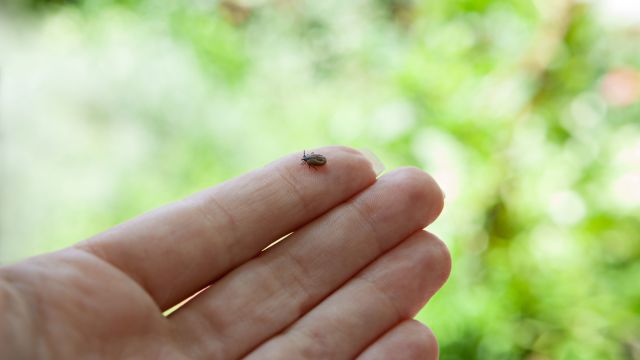According to estimates from the United States Centers for Disease Control and Prevention (CDC), about 300,000 people in the U.S. are infected with Lyme disease each year, although only around 30,000 cases are actually reported. The good news is that Lyme disease is preventable and treatable, especially if caught early.
Lyme disease at a glance
Lyme, an inflammatory disease that can affect multiple organs in your body, is caused by a bacterium—Borrelia burgdorferi, or B. burgdorferi—which is transmitted via a bite from a tick. It’s the most common vector-borne illness in the US.
Currently there are 82 species of ticks in the US and they transmit at least 10 known diseases in humans. However, only one, the blacklegged deer tick, transmits the bacterium that causes Lyme. Nearly all reported cases of Lyme disease occur in 14 states, from Virginia through the northeast and as far west as Minnesota.
Just because you found a tick on you doesn’t mean you will contract Lyme disease. “The tick usually has to be on your body for 24 to 48 hours before it will transmit the disease,” says Michael Zimring, M.D., director, The Center for Wilderness and Travel Medicine at Mercy Medical Center in Baltimore. “If you get the tick off properly, you probably won’t get the disease.” Furthermore, you can only get Lyme disease from a tick that’s already infected. Regardless, it is important to remove a tick carefully and quickly, because other diseases can be transmitted more quickly.
The risk for Lyme disease is highest when ticks are in the nymph stage, just before they become adults. Although the prevalence of B. burgdorferi infection is twice as high in adult ticks, 90 percent of human disease transmission occurs from nymph ticks because they are so abundant in the summertime when people are outdoors. They’re small, too, which makes them hard to spot on your body.
The three phases of Lyme disease:
Early, localized disease. Within three to 30 days after an infected tick bite, may notice the classic bulls-eye rash, called erythema migrans, which occurs in 70 to 80 percent of people with Lyme. “You can have a large rash with a clear center, but it doesn’t have to be a clear center,” Dr. Zimring says. “It can be multiple rashes without a clear center.” The rash may be accompanied by a fever. Other common symptoms include headache, fatigue, swollen lymph nodes and achy muscles and joints.
Seek prompt medical treatment if you have symptoms and are in an area that has deer ticks—regardless if you actually recall a tick bite—only 25 to 30 percent of Lyme patients with early disease do.
Early, disseminated Lyme disease. Without treatment, Lyme disease may spread via the blood or lymph system, most commonly causing musculoskeletal or neurological symptoms, such as nerve numbness or pain, facial palsy, heart palpitations, chest pain and shortness of breath. In some cases, it may also cause heart or eye problems.
Late, or chronic, Lyme disease. At this point, the bacteria has spread throughout the body. About 50 percent of patients who don’t receive treatment experience rheumatic and neurological symptoms months and years after being bitten. Common symptoms include joint and muscle pain, along with joint swelling, muscle weakness, speech problems, cognitive issues and numbness and tingling.
Preventing and treating Lyme disease
Take precautions. Wear protective clothes when outdoors during tick season, opting for long sleeves and long pants if hiking in woods or tall grass. Apply a repellent that contains 20 percent (or higher) DEET, picaridin or IR3535 on exposed skin and over clothes. Use 0.5 percent permethrin on clothes or buy pre-treated clothing. “If you’re out in wooded areas, avoid high grasses and stay in the center of the path,” says Dr. Zimring.
Look for and remove ticks. After being outdoors, do a full body tick check, especially warm, moist areas, such as the groin and under the arms. Check your scalp, in your hair and in your belly button as well. Parents should check their children—and don’t forget family pets who have been outdoors as well.
If you find a tick, remove it promptly. Use small tweezers and grab the tick as close to the skin as possible. Pull straight up without twisting the tick. You can also scrape it off with your fingernail or the edge of a credit card. Clean the area thoroughly with alcohol or soap and water. “Make sure you get the whole head and try not to squeeze it,” says Dr. Zimring. Seek out medical help if you don’t believe you were able to remove the entire tick. If you find a tick on your clothes, put them in the dryer on high heat for at least 10 minutes, but longer if clothes are damp.
Seek medical attention. Dr. Zimring says if a patient was in a high-tick area and has symptoms, he wouldn’t wait for the results of a Lyme test. “If I suspect a patient has Lyme, I’ll treat it with three weeks of doxycycline or another antibiotic.” This is the standard treatment for early, localized and early, disseminated Lyme disease. With early antibiotic treatment the prognosis is usually good.
Roll out the red carpet for your neighborhood opossums. You read that right. According to the National Wildlife Federation, opossums “Hoover” up ticks on the forest floor—at the rate of about 4,000 per week! Don’t interact with your local opossum though. They can carry infections like flea rickettsiosis, salmonella and leptospirosis.





